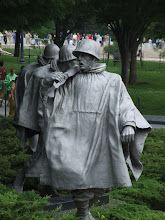

On the way south to Ticonderoga, we crossed lake champlain at crown point another important fort of the 1750s. The French built Fort St. Frederic on this site in the 1730s to control the lower reaches of Lake Champlain from the British and to overawe the native indians. This building included an immense stone tower more in keepiong with a medieval city than a frontier fort. As British aspirations on lake champlain increased the French realised the weakness of the fort to modern cannons and destroyed the fort at the approach of a British invasion force under Gen. Sir Jeffrey Amherst in 1759. The British immediately recognised the importance of this area for control of the lake and began construction of their own fort at Crown Point.


The fort was built in the typical Vauban style of the period with a central parade ground and mess buildings and a series of blockhouses and redoubts beyond the walls of the fort to protect the landward side. The fort was garrisoned weakly in the american war of indepence and was captured and used as a base for Gen. Benedict Arnolds campaign on the lake. With the loss of the American fleet at the battle of Valcour Island in 1776, the fort was abandoned. Despite a fire in 1773 destroying a large amount of the buildings inside the fort the walls and stone officers and soldiers quarters are still standing. A stroll around the walls is well worth the time. A small amount of remains from Fort St. Frederic can also be seen.
Travelling a few miles further south you come to Fort Ticonderoga. This impressively intact fort was begun by the French in 1755 and completed as Fort Carillon in 1758. The fort was attacked twice by the British in the Frecn Indian war. The first assault resulted in the catastrophic British defeat at the Battle of Carillon, 1758. Gen. James Abercrombie launched an unprepared assault against extensive abatis and field works placed by Gen. Montcalm some distance from the fort. The later siege resulted in the capture of the fort largely intact in 1759.


During the American Revolution (1775) a token garrison of British troops was captured along with large numbers of guns by Gen. Bendict Arnold, local hero Ethan Allen and the Green Mountain Boys. The guns were removed by Henry Knox through terrible winter weather to Boston where they formed the beginnings of the continental army's artillery.


The fort and the overlooking hill of Mount Independence were captured by the British in 1777 as part of Gen. John Burgoynes Saratoga campaign. Following the defeat of the British at Bemis Heights both Ticonderoga and Crown point were abandoned.


Today the fort is a well preserved tourist attraction, combining as it does key elements and characters from American Revolutionary history. some of the galleries are open and several have been restored to how they would have looked in the 1770s. During the summer a series of fife and drum and historical re-enactments occur.


It is nice to see that some countries make efforts to preserve their heritage. In the UK that would now be a rather dull "retail paradise"!
ReplyDelete